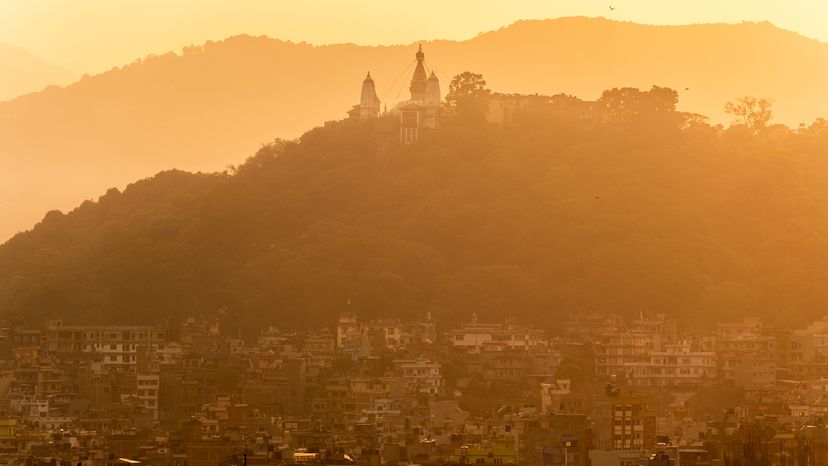To compile our ranking, we'll be looking at data from Yale University's Environmental Performance Index (EPI). The EPI ranking includes such important variables as PM 2.5, ozone, carbon monoxide, sulfur dioxide, volatile organic compounds and others. This data is from a report issued in 2024.
We'll also be using the Air Quality Life Index (AQLI) compiled by the University of Chicago. Their most recent compiled data is from 2022, when they released a report ranking countries of the world by air quality. The AQLI listing gives us the PM 2.5 number, which measures fine particulate pollution in the air.
1. Nepal
EPI rating: 6.1
PM 2.5: 39.18
Nepal has the unfortunate distinction of the worst air pollution levels in the world. Both outdoor air pollution and household air pollution are major problems in the country, which lags in development, effective regulations and infrastructure.
The buildup of fine particulate matter in the air comes from a variety of sources: Nepal's landlocked location, between China and India, and it's mountainous terrain, create natural "pollution sinks," which concentrate some of the industrial and urban air pollution from those two countries.
Old vehicles, infrastructure, burning of trash and even the lingering dust from the catastrophic 2015 earthquake are other serious factors.
2. Pakistan
EPI rating: 6.3
PM 2.5: 38.9
Coming in second place is Pakistan, which is the fifth-most populous country in the world. With dense, sprawling urban centers and an evolving mixture of industry and agricultural sectors, Pakistan has long struggled with environmental degradation.
Its ambient air pollution comes from a range of sources: constant emissions from vehicles and factories, seasonal agricultural practice (such as burning) and the combination of weather and geographical location.
3. Bangladesh
EPI rating: 6.3
PM 2.5: 54.17
Bangladesh, in third place, shares several attributes with its neighbors, such as China and India.
It's densely populated, with much of the recent population growth coinciding with mass migration to cities. Rapid industrialization and lax environmental standards have made Bangladesh home to some of the most polluted cities in the world, especially in terms of air quality.
Bangladesh also has a sizable brick industry, some of which is made up of large industrial operations, and some of which is small business or even family production. Heating these bricks means burning fossil fuels or other materials, all of which contributes to the problem of air pollution.
4. India
EPI rating: 6.8
PM 2.5: 41.39
India's struggle with air pollution has unfortunately become emblematic. A massive country — both in landmass and population — it's seen rapid economic growth in recent decades, but inconsistent and ineffectual environmental standards have meant this growth comes a great cost, with some of the lowest air quality in the world.
India's air pollution levels come from now-familiar sources: In the cities, there are lots of vehicles (especially ones that are old and whose emissions are especially toxic) and lots of factories. In the country, the bad air comes from fire: burning stubble to prepare agricultural land for the next year's crop, burning organic materials for heat and cooking, and even burning trash.
While efforts have been increasing to reduce air pollution levels in India, progress has been very slow.
5. Democratic Republic of the Congo
EPI rating: 8.1
PM 2.5: 34.20
The DRC has the fifth-worst air quality in the world. A country of astounding resource wealth, it's also a tragic case of exploitation, both of its people and its environment.
Much of the poor indoor air quality comes from wood stoves used by millions, and the ambient air pollution is from the familiar sources of densely populated cities, soot-spewing small vehicles and unregulated heavy industry.
Terrible, chronic armed conflict has also kept the DRC from the stability that would allow for more eco-conscious regulations and economic development. Experts in world air quality have long noted that being poor is a health hazard, and countries like the Democratic Republic of the Congo, with relatively poor health outcomes, show just how true this is.
6. Rwanda
EPI rating: 8.4
PM 2.5: 33.37
Rwanda, like its neighbor to the west (the DRC), struggles with both ambient air pollution and indoor pollution, often from the same sources. Indoor air pollution is especially problematic, with wood and charcoal cooking posing serious health risks, especially to the very young, the elderly, pregnant women and anyone with impaired health.
7. Myanmar
EPI rating: 9.0
PM 2.5: 28.64
Myanmar, in south east Asia, struggles with by-now familiar forms of air pollution, and with familiar sources. It's another country in the midst of urbanization and increasing industrialization, and all of the effects of those processes.
Myanmar's neighbors don't help, either: It's surrounded by other countries that have the same or similar problems, and when the wind blows the wrong way, Myanmar is negatively affected.
8. Burundi
EPI rating: 9.0
PM 2.5: 34.04
With Rwanda to the north and the DNC to the west, Burundi's air quality faces many of the same problems of its neighbors. Most of the population cooks on indoor wood stoves, and even in the more densely populated urban areas, there is very little adequate regulation of pollutants.
9. Lesotho
EPI Rating: 11.6
PM 2.5: 27.87
Lesotho is located entirely within the country of South Africa, making it an enclave of that country, technically. Lesotho's air pollution comes from a combination of different factors, including the burning of trash, as well as the nascent industries in the country.
Like many developing nations, the premium on growth often comes at expense of sustainability and environmental safety.
10. Republic of Congo
EPI Rating: 12.1
PM 2.5: 31.94
Yes, this is a different country than the one holding the No. 5 position on this list. Rounding out the top 10 is the Republic of Congo, a far smaller country than the Democratic Republic of the Congo.
Still, it also struggles with air quality, and all of the related health risks that come from breathing unhealthy air.
